fabricate - In general, to make; to create. Often more specifically, to construct or assemble something.
Some artists have relegated parts or all of their works' fabrication to others. Examples include Sol LeWitt, Vito Acconci, Laurie Anderson, Gilbert and George, Jeff Koons, Andy Warhol, numerous printmakers (artists working with master printers), and sculptors of especially large or technically demanding works.
|
At what point does the artist stop being the artist if responsibilities for fabrication are either shared or delegated entirely? How do we gauge the quality as well as authorship of a work which is fabricated partly or entirely by people other than the artist? Consider the authorship of motion pictures. Remember the endless credits rolling past at the end of every film. What enormous collaborative efforts they typically are! We experience them less intimately than we do most gallery pieces. Nevertheless they are (or can be) works of art. Who's the artist? (If you think only of paintings, sculptures, etc. by individual artists, you get into the mindset that something is art only if it's the product of a lone maker. What lone artist can actually be considered entirely apart from his society [context], however influential or removed that society is?) Looking at movie credits, we begin to assign artistic authorship by reading the job titles or descriptions. As in these filmic examples of creative visual art making, there doesn't have to be just one means of assessing credit. But if a gauge must be found, go for one that measures the decision-making: Who made what choices, for what reasons, how well, etc.? While craftsmanship is a highly significant issue, it's not so important who held the tools as who decided what the tools will do . . . what content, what composition with what materials, what shapes, colors, textures, sizes, etc., to what standards of craftsmanship? An artist can be an artist as a writer, as a director, as an actor, as a musician, etc. We enjoy our terms having relatively stable meanings on the one hand, but our awareness of their mutability is among the most delightful aspects of our enjoyment of the arts! |
Also see assemblage, carve, cast, creativity, form, manufacture, model, and mold.
façade - The front or face of a building. The façade accents the entrance of a building and usually prepares the visitor for the architectural style found inside. Also, any other sides of a building when they are emphasized architecturally.
(pr. fə-SAHD)
Also see elevation and frontispiece.
face - Often the subject of portraits, the surface of the front of the head from the base of the chin to the top of the forehead and from ear to ear; a person's or creature's countenance, mug, or visage. Or, variously, the most significant or prominent surface of an object, especially either the surface presented to view, the front, a façade, an outer surface, a marked side, or the right side (as of fabric). May refer to the two-dimensional surface of a polyhedron. Face may also be used as a short version of typeface. And it may refer to the act of producing a surface or cover of a different material, as in marquetry, mosaic, and ormolu.
facsimile - An exact copy or reproduction, as of a document. A method of transmitting images or printed matter by electronic means, usually by telephone. Also, an image transmitted this way, commonly called a fax.
(pr. fack-SI-mə-lee)
Also see appropriation, counterfeit, forgery, homage, likeness, mirror, representation, simulacrum, and simulation.
faience or faïence - glaze earthenware. Although the term originally referred only to the tin glazed earthenware made at Faenza, Italy, it is sometimes used to refer to a paste which produces a glaze-like surface when fired. Also, glazed earthenware used for architectural purposes. Although the term is sometimes used to mean pottery of all kinds, this breadth of meaning is widely considered incorrect.
(pr. feye-AHNS)
Examples of Egyptian faience (a paste of ground quartz, producing a glazed surface) as well as of Greek faience:

Egypt, Sphinx of Amenhotep III, c. 1391-53 BCE,
Dynasty 18, reign of Amenhotep III, New Kingdom, Egyptian faience, length
9 7/8 inches (25 cm), Metropolitan Museum of Art, NY. See Egyptian art.

Egypt, Lotiform Cup, c. 945-715 BCE,
Dynasty 22, Third Intermediate period, Egyptian faience, height 5 3/4 inches (14.6 cm),
Metropolitan Museum of Art, NY.
Egypt, Statuette of the Goddess Taweret, Late Period, c. 712 - 30 BCE, Egyptian faience, 4 1/4 x 1 1/2 inches (10.8 x 3.8 cm), Michael C. Carlos Museum, Michael C. Carlos Museum, Emory U, Atlanta, GA. See statuette.

Egypt, Statuette of Isis and Horus, 304-30 BCE,
Ptolemaic period, Egyptian faience, height
6 3/4 inches (17 cm), Metropolitan Museum of Art, NY.
![]()
Greek (Seleucid or Ptolemaic), 2nd century
BCE,
Faience Alabastron, glazed terra
cotta, 9 1/16 inches (23 cm), J. Paul Getty Museum, Malibu,
CA. See alabastron.
Also see lead glaze and majolica.
fake - Having a deliberately false or misleading appearance; forgery, counterfeit; not authentic, not genuine. Or, to intentionally forge, counterfeit.
Also see ersatz, original, and paint-by-number.
fame - Great reputation and recognition; renown. Fame is famously a mixed blessing. As something to strive for, it is easily confused with notoriety or clever marketing. Better to strive for success through the attainment of great quality in one's work (preferably in a satisfying quantity), amidst love, and ultimately for posterity.
Quotes:
Related link:
Also see eccentric, genius, masterpiece, posthumous, praise, publicity, and quality of life.
fan - A device which creates a breeze when moved. The shape of most hand-held fans is distinctive, providing a surface or form for the work of artists and craftsmen of many cultures. The folding fan was probably invented in Japan in the 7th century. A synonym for fan-shaped is "flabellate."
Examples:
![]()
Ding Yunpeng (Chinese, active 1584-1638),
Landscape with Figures under a Tree,
1616, fan painting; ink and gold leaf on paper;
signature: Ding Yunpeng; seals:
one of the artist and two of collectors, Worcester Art Museum,
MA. See Chinese
art.

American, Fan, c. 1860, supports:
black wood painted with floral design, upper portion: hand-colored
engraving
on heavy paper. Rendered by Frank
J. Mace, Fan, 1935/1942, watercolor
and graphite on paper, 43
x 50 cm (16 15/16 x 19 11/16 inches, Index of American Design,
National gallery of art, Washington, DC. See Index
of American Design.

Camille Pissarro (French, 1830-1903), Fan Mount: The Cabbage Gatherers, gouache on silk, 6 1/2
x 20 1/2 inches (16.5 x 52.1 cm), Metropolitan Museum of Art,
NY. See Impressionism
and mount.

Lovis Corinth (German, 1858-1925), Fan Design, recto,
probably 1906, graphite on
green paper, lunette: 24.1
x 46.8 cm (9 1/2 x 18 7/16 inches), National Gallery, Washington,
DC. See secession.

Miriam Schapiro (Canadian-American, 1923-),
Mother
Russia, fan, 1994, acrylic
and mixed media on canvas,
82 x 90 inches. This type of collage
is known as femmage. See feminism
and feminist art.
In Hindu art the fan or fly-whisk is one of the attributes of the god Shiva, especially in Indonesia. But Shiva is not the only figure to hold this attribute. It occurs frequently as an attribute of other Hindu and Buddhist deities. Heavenly servants often have a fan or fly-whisk to cool their master and to keep away insects.
Also see lunette.
fanciful - Fantastic.
fantastic - Sometimes used to indicate an imaginative, subjective world of inner expression that transcends mere fantasy or science fiction. The paintings of Richard Dadd (English, 1817-1886) are often described as fantastic in this sense.
Example:

Richard Dadd (English, 1817-1886), The Fairy Feller's Master-Stroke, 1855-64,
oil on canvas,
54.0 x 39.4 cm, Tate Gallery, London. After murdering his father
in 1843, Dadd was diagnosed as insane and spent the rest of his
life in asylums. Cut off from the outside world, he produced
a series of paintings which combine a remarkable attention to
detail with an individual, manic intensity. A fairy woodman stands
with his axe at the center of this composition, observed by numerous characters
from Shakespeare's play A Midsummer Night's Dream, including
the fairy king and queen Oberon and Titania, along with the fairy
Queen Mab, who rides in her chariot. The horror
vacui apparent in Richard Dadd's pictures may be a result
of his severe mental illness. See art
brut.
Fantastic is often used loosely to mean very good. Also see chinoiserie, deformalism, expressionism, fanciful, folk art, grotesque, oneiric, pain, praise, singerie, Surrealism, Symbolism, and ugly.
fantasy - The creative imagination, or what it produces. Art characterized by highly fanciful or supernatural elements. From imagined events or sequences of mental images, such as daydreams to the more psychologically charged delusions and hallucinations. In psychological criticism, fantasy can be either creative or adjustive (i.e., compensatory). Also see fifth dimension.
Example:

John Anster Fitzgerald (English, 1819-1906),
The Fairy's Lake, 1866, oil
on board, 15.2 x 203 cm, Tate Gallery, London.
Quote:
Also see expressionism, fanciful, folk art, grotesque, mystery, oneiric, Surrealism, Symbolism, and ugly.
fan vault - A development of lierne vaulting characteristic of English Perpendicular Gothic, in which radiating ribs form a fan-like pattern.
FAP - Acronym for Federal Art Project, one of the "alphabet soup" of federal projects supporting New Deal art projects.
Farm Security Administration (FSA) - An agency of the U.S. government in the Agriculture Department during the Great Depression of the 1930s and 1940s. It was a part of the federal bureaucracy which administered New Deal art programs. It had earlier been the Resettlement Administration (RA).
Example of work produced under the FSA:

Gordon Parks (American, 1912-), American Gothic, 1942, photograph. Gordon
Parks first worked in 1942-43 as a photographer under Roy Stryker
in the Farm Security Administration (FSA). See American
Gothic.
farrago - A motley assortment or a medley; a jumble or conglomeration; a hodgepodge. This obscure word was derived from a Latin word meaning mixed fodder. Use of "farrago" has increased among art writers in the early 2000s. The plural form can be farragoes or farragos.
(pr. fə-RAH-go or fə-RAY-go)
Also see appropriation, assemblage sculpture, bricolage, collage, construction, homage, incongruity, parody, and pastiche
fascist aesthetic - Refers to the art, design and propaganda presented in idealized realist styles, giving it a close resemblance to socialist realism, associated primarily with or produced by Adolph Hitler's Nazi Germany, Benito Mussolini's Italy, and Francisco Franco's Spain, from the 1930s to the mid-1940s. Adolf Hitler (1889-1945) branded modernist art entartete — degenerate or degenerative. The fascists favored a strongly classicalstyle in contrast to the prevailing artworld styles of Cubism, Surrealism, Expressionism, Dadaism, and Modernism in general. Hitler believed that modern art was in conflict with the eternal values of beauty and therefore could only lead to a decline of civilization. Men were depicted as patriotic, heroic and powerful, while women were neat and clean, with muscular legs and full breasts. They were often depicted as Nordic or "Aryan" — generally light blonde and very white-skinned — reflecting myths of Aryan superiority. The most prominent German artists of this style were sculptor Arno Breker and painter Adolf Wissel. Rather than censor modernist art, the Nazis confiscated it, and mounted exhibits of what they called "degenerate art." They expected Germans to recognize these works as presenting "negativity and the incomprehensibility of the world," which pitted modernist aesthetics against what fascists characterized as their own positivism, progressive goals, and noble ideals — an ostensibly hopeful Weltanschauung (world-view) that led to their ruthlessly forcing their "solutions" on the world.
(pr. FA-shəst əs-THə-tək)
Example:
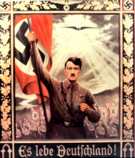
German, Long live Germany!, after 1936, poster, collection of Dr. Robert D. Brooks. This portrait of Hitler casts him as a sainted hero. A Holy Spirit-like / dove-like eagle flies in the radiant glow above an idealized Hitler, reminiscent of Baroque paintings of Christ in scenes with John the Baptist. See flag and propaganda.
Quote:
Related links:
Also see Futurism, Bauhaus, German art, iconomachy, and ugly.
fashimite - A person who is a slave to fashion; a fashion addict.
fat - Describes an oil paint having a high proportion of oil.
Also see fat over lean and lean.
fat over lean or fat over thin - The recommended means of layering oil color: the first layer of oil colors should be leanest (least oil, or more thinner with less oil) followed by layers with progressively more fat (more oil.) Following this principle results in a work less likely to crack after aging. Conversely, in order to encourage cracking, the painter should do the reverse.
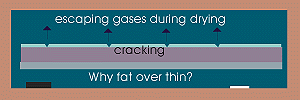
Other sites concerned with fat over lean:
Also see crackle, overpainting, surface, and underpainting.
faux - French for false, artificial,
fake. English speakers say "faux" to give a high-toned
quality to what is often an
imitation of a natural
material — leather,
fur, metal, or stone for example. Although faux materials are usually less expensive
than the real thing, there can be other advantages to them: durability,
uniformity, weight, color,
and availability perhaps. There can be allegorical advantages too (falsity can have its purposes!) particularly when juxtaposed with opulence. Faux
finishes are painted simulations of other materials — the look of their colors and textures. Examples include:
stones (marble, granite, sandstone, malachite, porphyry, serpentine, lapis, etc.), wood (also called faux bois — false wood), masonry,
and metal (gold, silver,and bronze,
(gold, silver,and bronze, 
 along with all of their potential patinas). A faux marble might
be a substitute like terrazzo or scagliola, each of which employ
marble dust in a plaster binder
to result in a hard material that will take a polish.
See the article on "marbling"
for a discussion of marbling papers as well as faux-marbling as
a painting technique.
along with all of their potential patinas). A faux marble might
be a substitute like terrazzo or scagliola, each of which employ
marble dust in a plaster binder
to result in a hard material that will take a polish.
See the article on "marbling"
for a discussion of marbling papers as well as faux-marbling as
a painting technique.
(pr. foh)
Also see copy, counterfeit, forgery, gold leaf, likeness, marbling, naturalism, silver leaf, simulacrum, stipple, tortoiseshell, trompe l'oeil, and truth.
fax - See facsimile.
Fayum portraits - A Romano-Egyptian portrait painted with encaustic on cartonnage, a linen mummy case, or a wood panel. For thousands of years Egyptian religious beliefs called for funerary portraits; in Pharaonic times these representations were very formulaic. When Egypt came under Roman influence during the 1st through 3rd centuries CE, the Roman taste for highly individualized portraiture altered the style of the Egyptian mummy portrait. These portraits were either created during the subject's life, or just after death, and fitted into the mummy wrappings, above the face of the deceased. They are often referred to as Fayum portraits because many examples were found in the Fayum region of Egypt. Fayum is about one hundred kilometers south of Cairo.
(pr. fay-YəM)
Examples:
![]()
Roman, Fayum, Egypt, 100-125 CE,
Attributed to the Isidora Master, Mummy Portrait of a Woman, Isidora, encaustic
and gilt on a wooden panel wrapped
in linen, 13 1/4 x 6 3/4 inches (33.6 x 17.2 cm), J. Paul Getty
Museum, Malibu, CA.

Egypt, second century CE
(Roman Period), Portrait of a Boy, encaustic on wood,
15 3/8 x 7 1/2 inches (39 x 19 cm), Metropolitan Museum of Art,
NY. See Egyptian
art.
Egyptian (Hawara, Roman Period, second century CE), Funerary Portrait of a Young Girl, encaustic on wood, height 15 3/4 inches, Cleveland Museum of Art.
Also see Egyptian art.

Federal Art Project (FAP) - An agency of the U.S. Government during the Great Depression of the 1930s and 1940s. It provided employment for artists as part of a larger agency, the Works Progress Administration (WPA), one of several federal entities which administered New Deal art programs.
Examples:
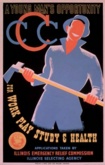
Albert Bender (American), Federal Art Project,
Chicago, C.C.C. A Young Man's Opportunity for Work Play
Study & Health, c. 1935, silkscreen, Library of Congress, Washington,
DC.
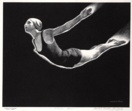
Mabel Wellington Jack (American, 1890-1970),
Swan
Dive, c. mid-1930s, lithograph,
Library of Congress, Washington, DC.

Harry
Sternberg (American, 1904-), Builders, 1935-1936, lithograph, stamped: Federal Art Project
WPA NYC.
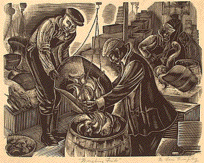
M. Lois Murphy, 1901-1962), Weighing Fish, 1936-37, wood
engraving on paper, Library of
Congress, Washington, DC. Lois Murphy produced Weighing Fish
while affiliated with the Federal Art Project (FAP) in New York
City.

Federal Art Project, Art Teaching Division,
Free
Instruction for Children in Painting and Drawing, c.
1936, poster,
Work Projects Administration Poster Collection, Library of Congress,
Washington, DC. See poster.
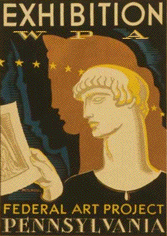
Katherine Milhous (American, 1894-), Exhibition:
WPA Federal Art Project Pennsylvania, c. 1936-38, poster,
color woodcut.
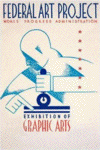
American, Federal Art Project Exhibition of Graphic Arts,
poster.
![]()

![]()
Harry Herzog (American), City of New York Municipal Airports,
c. 1935, poster.
Jerome Henry Rothstein (American, 1918-), Federal Art Project, New York, Federal Art Project 1939, calendar.
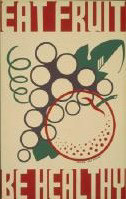
Federal Art Project, Eat Fruit, Be Healthy, c. 1938, poster, Library of Congress, Prints
& Photographs Division, WPA Poster Collection, Washington,
DC.
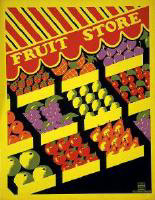
Federal Art Project, New York, Fruit Store, c. 1941, poster, Library of Congress, Prints
& Photographs Division, WPA Poster Collection, Washington,
DC. See diagonal.
feet - See foot.
felts - Absorbent pads used to dry the sheets in papermaking. Also see absorption.
femmage - A type of collage that includes textile art, traditionally produced by women.
(pr. fə-MAHZH)
Example:

Miriam Schapiro (Canadian-American, 1923-),
Mother
Russia, fan, 1994, acrylic
and mixed media on canvas,
82 x 90 inches, Courtesy of Steinbaum Krauss Gallery.
Also see bricolage, collage, confection, coulage, découpage, farrago, feminism and feminist art, frottage, fumage, montage, parsemage, and photomontage.
fenestration - The design and arrangement of windows in architecture. Architects sometimes refer to the windows of a building as the glazing.
(pr. fə-nə-STRAY-shən)
Examples:

Combining a triangle with a rectangle, this
window is part of the Renaissance
palace designed by Andrea Palladio (Italian, 1508-1580). The
Villa Rotonda (Villa Capra), begun in
1567, near Vicenza, Italy. See Palladian.

Anselm Kiefer (Germany, 1945-),
Der Blocksberg, 1995, gelatin-silver prints, acrylic, emulsion, ashes, fabric, and oil pastel, 41 x 29 x 3 1/2 inches (104.14 x 73.66 x 8.89 cm), Los Angeles County Museum of Art. This is fenestration taken as a subject of a work by a contemporary painter, incorporating references to issues in Germany's WWII history. See Neo-Expressionism.
Internet resources concerned
with fenestration:
By the way, "defenestration" is jumping out of windows.
Also see glass, lattice, lunette, oculus, openwork, rectangle, and square.
feng shui - The traditional Chinese practice of arranging objects in architectural and burial spaces in order to harmonize with the flow of chi (qi) — the vital force believed in Taoism and other Chinese thought (including its divination and astrology) to be inherent in all things. Feng shui literally means "wind and water," symbolizing all space between heaven and earth. Feng shui understands chi as moving like wind and water. Its principles rest upon the properties of various objects and their relationships on a number of levels (including light, sound, movement, electricity, symbolism, and color, along with other functional and transcendant issues) to increase or decrease the flow of chi. Trapping chi, for instance, is described as making its flow eddy and stagnate. Any of various types of flow may be best for various reasons, dependent upon a balancing of yin and yang — the opposite possibilities of all situations. Study and use of Feng shui's principles can stimulate and regulate creativity, aesthetics, and functionality in the design of any environment, in order to enhance health, wealth and happiness.
(pr. fung shway)
Related resources:
Also see composition, decoration, environment art, iconomancy, installation, mirror, negative space, placement, positive space, principles of design, taxis, and theory.
feretory - See reliquary.
ferro concrete - See reinforced concrete.
(pr. FEH-roh con-KREET)
ferrotype - In photography, a positive image made directly on an iron plate varnished with a thin photosensitive film; also called a tintype. Or, the process by which they are made. The ferrotype process was introduced to the USA in 1855.
(pr. FEH-roh-ti:p)
Examples:

Unidentified photographer (American?), Woman looking at framed tintype portraits, c. 1870,
tintype with decorative paper mat,
12.4 x 7.7 cm, George Eastman House, Rochester, NY.
Unidentified Photographer, Man and Childs Hands, c. 1875, tintype, 7.8 x 4.9 cm Eastman Kodak House, Rochester, NY.
ferrous - Composed of or containing iron. Ferrous metal include alloys of iron, such as steel. Only ferrous metals are capable of magnetization.
(FEH-rəs)
ferrule - The metal or plastic device that that aligns and anchors paintbrush bristles or hairs in an adhesive. The ferrule is attached to the handle by crimping or by binding wires. The ferrule pictured here has a brassy color.
(pr. FEH-rool)
festoon - Decorate with a garland or chain of flowers, leaves, etc., suspended in a curve between two points.
Also see bric-a-brac, egg-and-dart, molding, and ornament.
fête galante - An elegant and graceful outdoor celebration, such as those seen in the picnics and flirtatious games often represented in the works of Antoine Watteau (French, 1684-1721) and other Rococo painters of French aristocratic life.
(pr. fayt gah-LAHNT or fet gah-LAHNT)
Examples:
Jean-Antoine Watteau (French, 1684-1721), The Pilgrimage to Cythera, 1717, oil on canvas, 1.29 x 1.94 m, Louvre.

Nicolas Lancret (French, 1690-1743), Conversation Galante, before 1719, oil on canvas,
relined, 68.3 x 53.5 cm, Wallace Collection, London. See conversation piece.

Jean Baptiste Joseph Pater (French, 1695-1736),
The Fair at Bezons, c. 1733, oil
on canvas, 42 x 56 inches
(106.7 x 142.2 cm), Metropolitan Museum of Art, NY.
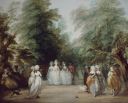
Thomas Gainsborough (English, 1727-1788),
The
Mall in St. James's Park, c. 1783, oil
on canvas, 47 1/2 x 57 7/8
inches (120.6 x 147 cm), Frick Collection, NY.
Jean-Honoré Fragonard (French, 1732-1806), The Progress of Love, ten panels: four painted in 1771-73, six painted panels in 1790-91, oil on canvas, heights of the taller panels c. 125 inches (317.5 cm), of the four overdoors c. 59 inches (150 cm), with varied widths, Frick Collection, NY.

Pierre-Auguste Renoir (French, 1841-1919), The Luncheon of the Boating Party (Le déjeuner des canotiers), 1881, oil on canvas, 51 x 68 inches (129.5 x 172.7 cm), Phillips Collection, Washington, DC. The Collection offers The Story Behind the Masterpiece. See Impressionism.
Also see conversation piece and genre.
fetish - An object believed to have magical powers, especially one capable of bringing to fruition its owner's plans; sometimes regarded as the abode of a supernatural power or spirit.
(pr. FE-təsh)
Examples:

Africa, Zaire, Yombe, Chiloango River valley,
Standing male figure (nkisi nkondi, mangaaka
type), nineteenth century, wood,
iron, raffia,
pigment, kaolin and red camwood,
44 x 15 5/8 x 1 3/8 inches (111.8 x 39.7 x 3.5 cm), Dallas Museum
of Art. See African
art.

Africa, Zaïre, Yombe or Woyo, Fetish, wood,
nails, metal
fragments, small chain, traces of polychrome,
97.5 x 47 x 28 cm, Georges Pompidou Center, Paris.
![]()
Henri Gaudier-Brzeska (English, born France,
1891-1915), The Imp, c. 1914, alabaster, 40.6 x 8.9 x 8.3 cm, Tate Gallery,
London. The Imp shows the influence of Gaudier-Brzeska's
study of fetishes. Its almost phallic form reflects a commonly
held association between the 'primitive'
and an energising sexuality.
In 1914, Gaudier-Brzeska wrote in Blast in praise
of the fetishes and love charms
of Africa and
Oceania as masterpieces that emerged from a 'vortex of fecundity'.
The contemplation of sexuality, he claimed, provided 'great energy'.
See Vorticism.
Also see amulet, ex voto, milagro, talisman, and votive.
fettling - The process of cleaning and finishing the surface of a piece of clay or metal work, especially the edges, and in the case of cast work, the seam lines (flashing).
![]()
![]()
![]() fettling knife
- A knife designed for working with clay.
To fettle is to trim unwanted clay from edges,
etc. Also called a potter's knife.
fettling knife
- A knife designed for working with clay.
To fettle is to trim unwanted clay from edges,
etc. Also called a potter's knife.
https://inform.quest/_art